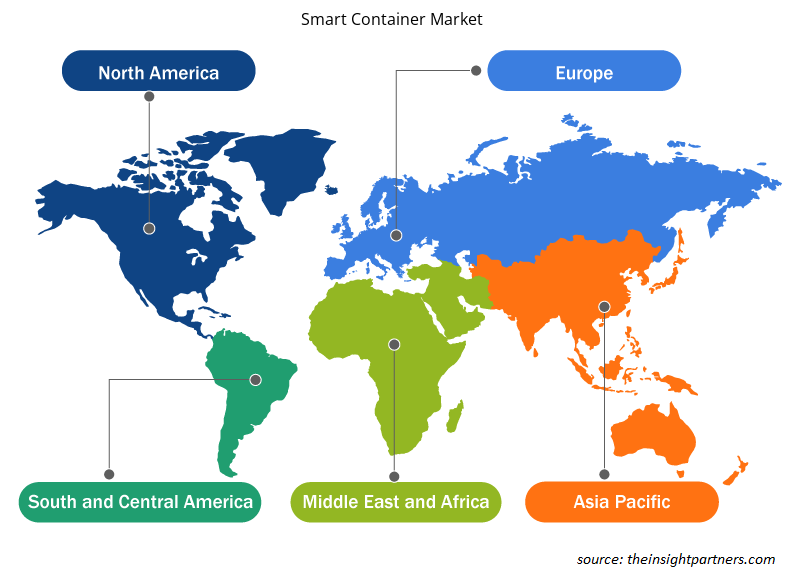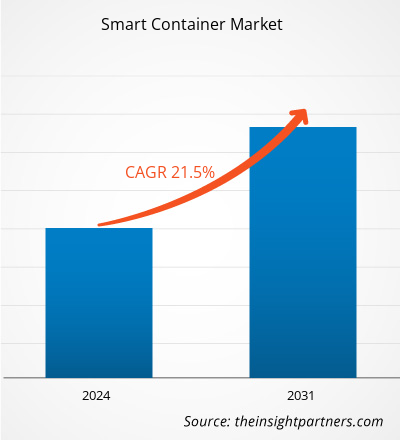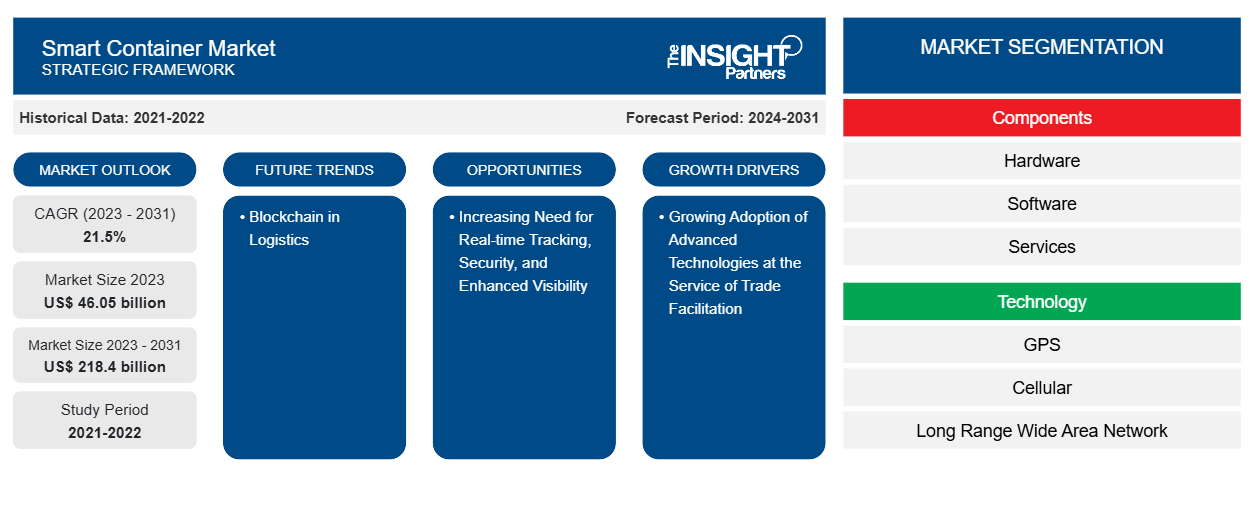Se proyecta que el tamaño del mercado de contenedores inteligentes alcance los 218.400 millones de dólares en 2031, frente a los 46.050 millones de dólares en 2023. Se espera que el mercado registre una CAGR del 21,5 % entre 2023 y 2031. El mercado está creciendo debido a la creciente demanda de envíos y seguimiento en tiempo real de las mercancías.
Análisis del mercado de contenedores inteligentes
La tecnología de contenedores inteligentes se puede vincular a otras innovaciones, como el big data, la cadena de bloques o los canales de datos, para brindar aún más apoyo a la comunidad comercial. Sin embargo, en todos estos casos, vemos que la creación de estándares de intercambio de mensajes claros y explícitos nos permitirá aprovechar todo el potencial de los datos mejorados.
Descripción general del mercado de contenedores inteligentes
Los contenedores inteligentes permiten que las líneas navieras y las partes interesadas en el transporte de mercancías tengan acceso a los datos de los contenedores procedentes de la fuente, independientemente de si el contenedor se encuentra en un barco, en un depósito o en cualquier otro punto durante su viaje previo o posterior al transporte. Los contenedores inteligentes están adoptando la Internet de las cosas (IoT) para mejorar la toma de decisiones por parte de los distintos actores del sector. Esto proporciona una visibilidad superior a los inversores dentro de la transacción, así como a las agencias reguladoras que necesitan información completa sobre los envíos antes de que lleguen a la frontera.
Personalice este informe según sus necesidades
Obtendrá personalización en cualquier informe, sin cargo, incluidas partes de este informe o análisis a nivel de país, paquete de datos de Excel, así como también grandes ofertas y descuentos para empresas emergentes y universidades.
-
Obtenga las principales tendencias clave del mercado de este informe.Esta muestra GRATUITA incluirá análisis de datos, desde tendencias del mercado hasta estimaciones y pronósticos.
Factores impulsores y oportunidades del mercado de contenedores inteligentes
Creciente adopción de tecnologías avanzadas al servicio de la facilitación del comercio para favorecer el mercado
Diferentes tecnologías permiten a los contenedores inteligentes comunicar información capturada a través de una amplia gama de sensores sobre su estado actual (por ejemplo, posición GPS, detección de apertura de puertas, movimientos, vibraciones y golpes, condiciones atmosféricas, etc.) y cambiar de forma remota sus ajustes de parámetros (por ejemplo, configuraciones de temperatura, descongelación remota, etc.) en cualquier lugar y en cualquier momento. Las tecnologías de IoT han demostrado que existe un enorme potencial para que las empresas aprovechen su eficiencia y mitiguen sus riesgos. Los activos inteligentes se convertirán en una característica común en la industria del transporte marítimo. Los contenedores inteligentes transmiten una gran cantidad de datos, que, combinados con otros datos en el sistema host primario, pueden analizarse e interpretarse para proporcionar evaluaciones aún más relevantes. Estos datos no solo son útiles durante el viaje de un solo contenedor. En el contexto de múltiples viajes durante un tiempo prolongado, pueden proporcionar visibilidad global de las operaciones. Al comparar los tiempos de respuesta promedio o las tasas de daños entre diferentes puertos y patios, se pueden crear y evaluar programas para llevar a todas las partes interesadas al mismo nivel de excelencia en la cadena de suministro. Por lo tanto, la creciente adopción de tecnologías avanzadas al servicio de la facilitación del comercio está impulsando el crecimiento del mercado de contenedores inteligentes.e.g., GPS position, door opening detection, movements vibrations and shocks, atmospheric conditions, etc.) and to remotely change their parameter settings (e.g., temperature setups, remote defrost, etc.) anywhere, anytime. IoT technologies have proven there is huge potential for businesses to leverage their efficiency and mitigate their risks. Smart assets will become a common feature in the shipping industry.Smart containers transmit a large amount of data, which, combined with other data in the primary host system, can be analyzed and interpreted to provide even more relevant evaluations. This data is not only useful during the journey of a single container. In the context of multiple trips over an extended time, it can provide global visibility of operations. When comparing average turnaround times or damage rates between different ports and yards, one can build and evaluate programs to bring all stakeholders up to the same level of supply chain excellence. Thus, the growing adoption of advanced technologies at the service of trade facilitation is driving the growth of the smart containers market.
Creciente necesidad de seguimiento en tiempo real, seguridad y visibilidad mejorada.
Una de las ventajas más valiosas de los contenedores inteligentes es la capacidad de registrar los envíos en tiempo real. El flujo constante de datos de estos contenedores permite a los proveedores de logística y a los clientes conocer el estado y la ubicación exactos de sus envíos en cualquier momento. Esta característica no solo mejora la precisión de la entrega y reduce las posibilidades de pérdida de envíos, sino que también permite la resolución proactiva de problemas, mejorando así significativamente el servicio al cliente. Los contenedores inteligentes también están revolucionando la seguridad logística a través de tecnologías como el geofencing, que puede generar alertas si los contenedores se desvían de su ruta predefinida o si se detecta un acceso no autorizado. Este nivel de seguridad es muy importante en el transporte de mercancías de alto valor o sensibles y desempeña un papel fundamental a la hora de disuadir el robo y mejorar la seguridad general de la cadena de suministro.
Análisis de segmentación del informe de mercado de contenedores inteligentes
Los segmentos clave que contribuyeron a la derivación del análisis del mercado de contenedores inteligentes son los componentes, la tecnología y la industria vertical.
- Según los componentes, el mercado de contenedores inteligentes se segmenta en hardware, software y servicios.
- Según la tecnología, el mercado de contenedores inteligentes está segmentado en GPS, celular, red de área amplia de largo alcance, Bluetooth de baja energía (BLE) y otros.
- Según la vertical de la industria, el mercado de contenedores inteligentes está segmentado en alimentos y bebidas, productos farmacéuticos, petróleo y gas, productos químicos y otros.
Análisis de la cuota de mercado de los contenedores inteligentes por geografía
El alcance geográfico del informe de mercado de contenedores inteligentes se divide principalmente en cinco regiones: América del Norte, Asia Pacífico, Europa, Oriente Medio y África, y América del Sur/América del Sur y Central. Los contenedores inteligentes están cambiando la experiencia del cliente en logística. El rastreo en tiempo real y la visibilidad mejorada significan que los clientes siempre están informados sobre el estado de sus envíos, lo que reduce la incertidumbre y mejora la confianza, lo que impulsa el crecimiento del mercado de contenedores inteligentes.
Perspectivas regionales del mercado de contenedores inteligentes
Los analistas de Insight Partners explicaron en detalle las tendencias y los factores regionales que influyen en el mercado de contenedores inteligentes durante el período de pronóstico. Esta sección también analiza los segmentos y la geografía del mercado de contenedores inteligentes en América del Norte, Europa, Asia Pacífico, Oriente Medio y África, y América del Sur y Central.

- Obtenga datos regionales específicos para el mercado de contenedores inteligentes
Alcance del informe sobre el mercado de contenedores inteligentes
| Atributo del informe | Detalles |
|---|---|
| Tamaño del mercado en 2023 | US$ 46.050 millones |
| Tamaño del mercado en 2031 | US$ 218,4 mil millones |
| CAGR global (2023 - 2031) | 21,5% |
| Datos históricos | 2021-2022 |
| Período de pronóstico | 2024-2031 |
| Segmentos cubiertos |
Por componentes
|
| Regiones y países cubiertos |
América del norte
|
| Líderes del mercado y perfiles de empresas clave |
|
Densidad de actores del mercado: comprensión de su impacto en la dinámica empresarial
El mercado de contenedores inteligentes está creciendo rápidamente, impulsado por la creciente demanda de los usuarios finales debido a factores como la evolución de las preferencias de los consumidores, los avances tecnológicos y una mayor conciencia de los beneficios del producto. A medida que aumenta la demanda, las empresas amplían sus ofertas, innovan para satisfacer las necesidades de los consumidores y aprovechan las tendencias emergentes, lo que impulsa aún más el crecimiento del mercado.
La densidad de actores del mercado se refiere a la distribución de las empresas o firmas que operan dentro de un mercado o industria en particular. Indica cuántos competidores (actores del mercado) están presentes en un espacio de mercado determinado en relación con su tamaño o valor total de mercado.
Las principales empresas que operan en el mercado de contenedores inteligentes son:
- Ambroso
- AP Møller-A/S
- Rastreador de globos, ApS
- Hapag-Lloyd AG
- Nexxoit AG
- Compañía Orbcomm Inc.
Descargo de responsabilidad : Las empresas enumeradas anteriormente no están clasificadas en ningún orden particular.

- Obtenga una descripción general de los principales actores clave del mercado de contenedores inteligentes
Noticias y desarrollos recientes del mercado de contenedores inteligentes
El mercado de contenedores inteligentes se evalúa mediante la recopilación de datos cualitativos y cuantitativos a partir de investigaciones primarias y secundarias, que incluyen publicaciones corporativas importantes, datos de asociaciones y bases de datos. A continuación, se incluye una lista de los avances del mercado:
- En febrero de 2022, la naviera francesa CMA CGM lanzó los contenedores SMART equipados con tecnología de última generación de Emerson, que permiten a los usuarios monitorear el estado y las condiciones del contenedor en tiempo real. Reciba datos clave como ubicación, temperatura y variaciones de gas.
(Fuente: CMA CGM, sitio web de la empresa, 2022)
- En octubre de 2023, Tower Cold Chain anunció una serie de nuevas iniciativas para KTEvolution, su solución de "caja pequeña" para envíos directos al paciente, de muestras y de última milla. Entre las nuevas ofertas se encuentra un servicio de "click & collect" para aerolíneas, compañías farmacéuticas y 3PL que alquilan los contenedores, así como la opción de comprarlos y personalizarlos.
(Fuente: Tower Cold Chain, sitio web de la empresa, 2022)
Informe sobre el mercado de contenedores inteligentes: cobertura y resultados
El informe "Tamaño y pronóstico del mercado de contenedores inteligentes (2021-2031)" proporciona un análisis detallado del mercado que cubre las siguientes áreas:
- Tamaño del mercado y pronóstico a nivel global, regional y nacional para todos los segmentos clave del mercado cubiertos bajo el alcance
- Dinámica del mercado, como impulsores, restricciones y oportunidades clave
- Principales tendencias futuras
- Análisis detallado de las cinco fuerzas de Porter y PEST y FODA
- Análisis del mercado global y regional que cubre las tendencias clave del mercado, los principales actores, las regulaciones y los desarrollos recientes del mercado.
- Análisis del panorama de la industria y de la competencia que abarca la concentración del mercado, el análisis de mapas de calor, los actores destacados y los desarrollos recientes
- Perfiles detallados de empresas
- Análisis histórico (2 años), año base, pronóstico (7 años) con CAGR
- Análisis PEST y FODA
- Tamaño del mercado, valor/volumen: global, regional y nacional
- Industria y panorama competitivo
- Conjunto de datos de Excel
Informes recientes
Testimonios
Razón para comprar
- Toma de decisiones informada
- Comprensión de la dinámica del mercado
- Análisis competitivo
- Información sobre clientes
- Pronósticos del mercado
- Mitigación de riesgos
- Planificación estratégica
- Justificación de la inversión
- Identificación de mercados emergentes
- Mejora de las estrategias de marketing
- Impulso de la eficiencia operativa
- Alineación con las tendencias regulatorias























 Obtenga una muestra gratuita para - Mercado de contenedores inteligentes
Obtenga una muestra gratuita para - Mercado de contenedores inteligentes